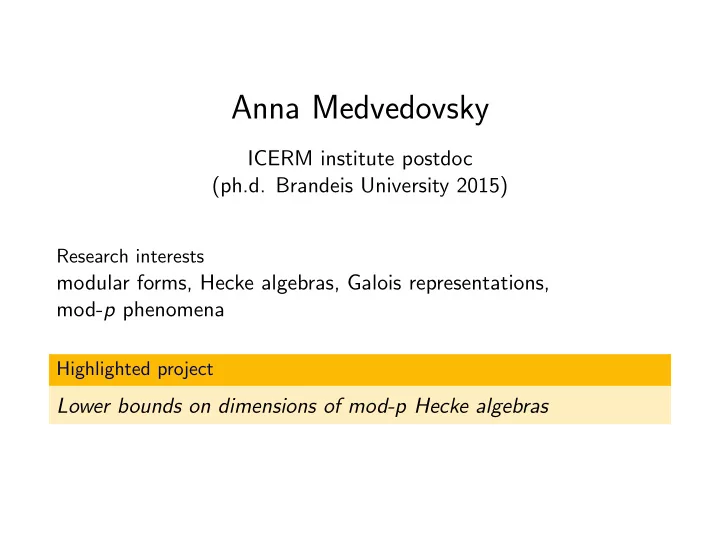

Anna Medvedovsky ICERM institute postdoc (ph.d. Brandeis University 2015) Research interests modular forms, Hecke algebras, Galois representations, mod- p phenomena Highlighted project Lower bounds on dimensions of mod-p Hecke algebras
Definitions p prime M ⊂ F p � q � space of modular forms modulo p (span of q -expansions mod p of modular forms of level one and any weight) A ⊂ End F p ( M ) Hecke algebra on M generated by all the T n with ( n , p ) = 1 (and completed: an inverse limit of Hecke algebras on finite subs of M ) We want to show that A is big (lots of modular forms).
How big? Theorem (Nicolas-Serre, 2012) If p = 2 , then A = F 2 � T 3 , T 5 � . Method: computation in characteristic 2. (Quite technical, completely elementary, combinatorial in flavor. Does not generalize.) Theorem (Bella¨ ıche-Khare, 2014) For p ≥ 5 , each local piece of A has Krull dimension ≥ 2 . Method: deduction from characteristic-zero results. (Gouvˆ ea-Mazur infinite fern implies that local pieces of char-zero Hecke algebra have dim ≥ 4.)
The nilpotence method Let m be a maximal ideal of A . To prove that dim A m ≥ 2, it is enough to see that the Hilbert-Samuel function k �→ dim F p A / m k grows faster than linearly . By duality, this is the same as finding lots of generalized eigenforms killed by m k .
Example: p = 3 Here M = F 3 [∆] and A is local with T 2 ∈ m . We look for many powers of ∆ killed by T k 2 . Key input (after Nicolas-Serre): The sequence { T 2 (∆ n ) } n of forms in M satisfies a linear recursion T 2 (∆ n ) = ∆ T 2 (∆ n − 2 ) − ∆ 3 T 2 (∆ n − 3 ) , n ≥ 3 . Theory of recursion operators in characteristic p (cf. my thesis) ⇒ the power of T 2 that kills ∆ n grows slower than linearly in n = ⇒ number of forms killed by T k = 2 grows faster than linearly in k . Corollary: dim A ≥ 2. More precisely, A = F 3 � T 2 , 1 + T 7 � .
Conclusion ◮ This method currently works for p = 2 , 3 , 5 , 7 , 13, recovering Nicolas-Serre and Bella¨ ıche-Khare (case p = 3 is new). ◮ Generalizations: any p , any level? ◮ Higher-rank groups: can this method say anything? How do you compute with these objects? Hence this semester at ICERM.
Recommend
More recommend